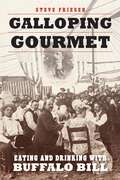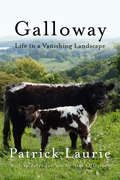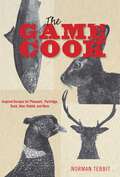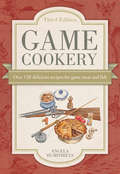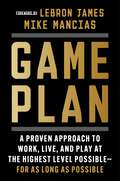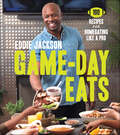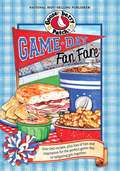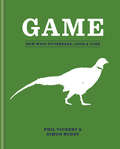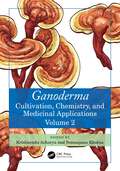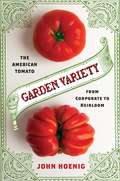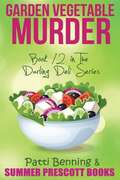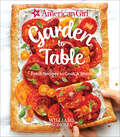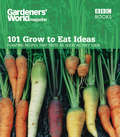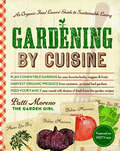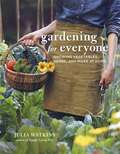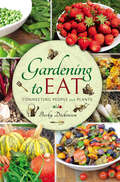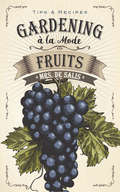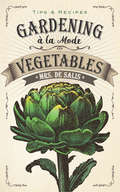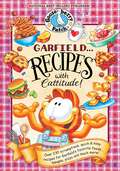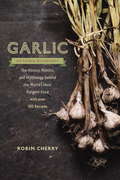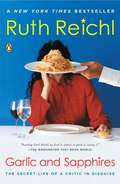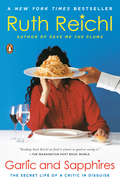- Table View
- List View
Galloping Gourmet: Eating and Drinking with Buffalo Bill
by Steve FriesenGalloping Gourmet explores an unfamiliar side of a familiar character in American history, William F. &“Buffalo Bill&” Cody. In this entertaining narrative Steve Friesen explores the evolving role of eating and drinking in Buffalo Bill&’s life (1846–1917). Friesen starts with Buffalo Bill&’s culinary roots on the American Plains, eating simple foods such as cornbread, fried &“yellow-legged&” chicken, and hardtack. Buffalo Bill discovered gourmet dining while leading buffalo-hunting expeditions and scouting. As his fame increased, so did his desire and opportunities for fine dining: his early show business career allowed him to dine at some of the best restaurants in the country. Friesen examines the creation of Buffalo Bill&’s Wild West Show in 1883, in which Cody introduced his diverse cast of employees to dining that equaled America&’s best restaurants. One newspaper reporter observed that &“Colonel Cody displays no more care about anything than the proper feeding of horse and man.&” Cody opened the first Mexican restaurant east of the Mississippi and introduced American foodways to Europe. Equally comfortable eating around a campfire on the plains or at Delmonico&’s in New York City, he also dined with leading celebrities of his day. In the final section Friesen addresses the controversies surrounding Cody&’s drinking, his death, and his ongoing culinary legacy. Galloping Gourmet includes an appendix of more than thirty annotated period recipes.
Galloway: Life In a Vanishing Landscape
by Patrick LaurieOn the land of his ancestors in Scotland, a young farmer struggles to find a balance between farming, the conservation of wild, and human culture as he establishes a herd of heritage cattle.Galloway, an ancient region in an obscure corner of Scotland, has a proud and unique heritage based on hardy cattle and wide moors. But as the twentieth century progressed, the people of Galloway deserted the land and the moors are transforming into a vast commercial forest. Desperate to connect with his native land, Patrick Laurie plunges into work on his family farm. Investing in the oldest and most traditional breeds of Galloway cattle, he begins to discover how cows—and the special care that this breed requires—once shaped people, places, and nature in this remote and half-hidden place. As the cattle begin to dictate the pattern of his life, Laurie stumbles upon another loss; the new forests have driven the catastrophic decline of the much-loved curlew, a bird that features strongly in Galloway's consciousness. The links between people, cattle, and wild birds become a central theme as Laurie begins to face the reality of life in a vanishing landscape. Exploring the delicate balance between farming and conservation while recounting an extraordinarily powerful personal story, Galloway delves into the relationship between people and places under pressure in the modern world.
Game Cook: Inspired Recipes for Pheasant, Partridge, Duck, Deer, Rabbit, and More
by Norman TebbitHow to shop for, prepare, and cook game—including 70+ mouthwatering recipesOn visiting his local butcher, Norman Tebbit—food lover, family cook, onetime politician, and journalist—wondered why people would rather buy tasteless, rubbery chicken when they could eat good-quality game. In this exciting new cookbook, he showcases his favorite game recipes—including pheasant, partridge, duck, grouse, wood pigeon, woodcock, deer, rabbit, and many more. Whether a relatively simple casserole or a more challenging creation, Tebbit’s more than seventy easy-to-follow recipes guarantee consistent results. And to help the reader along, he also includes instructions on preparation and equipment to use, as well as individual hints and tips on the various game included. Peppered with delightful anecdotes and lovely illustrations, this charming little cookbook is the ideal gift for anyone who loves good food, cares about where their food comes from, and is interested in tasty, wholesome game dishes.
Game Cookery: Over 120 Delicious Recipes for Game Meat and Fish
by Angela HumphreysDelectable recipes for those who hunt and fish—or any cook who want to try something new. The updated edition of this popular cookbook adds twenty new game recipes; now, you can indulge your taste buds with more than 120 delicious recipes for cooking grouse, partridge, pheasant, duck, rabbit, venison, and other game. These easy-to-follow recipes include dishes appropriate for everyday family meals, special occasions, picnics, and barbecues. Game is naturally low in fat and calories and is an ideal part of a healthy diet. A guide for preparing game so that it is fit to be eaten is included, as is an assortment of recipe accompaniments such as sauces, stuffings, and salads. With eighteen full-color illustrations by the well-known wildlife artist John Paley, this is an attractive and useful gift for all those keen on cooking what they hunt, shoot, and fish.
Game Plan: A Proven Approach to Work, Live, and Play at the Highest Level Possible—For as Long as Possible
by Mike ManciasFrom the trainer and high-performance expert behind LeBron James and other superstars, a blueprint to achieving peak physical and psychological well-being—and sustaining it for the long haul. With a foreword by LeBron.“Mike Mancias is more than a teacher or trainer, his approach to health and wellness is an approach to life. If you stay ready, you ain’t gotta get ready.” —UsherMike Mancias has spent two decades developing and refining a winning blueprint for athletic excellence. He’s worked with countless professional athletes, sports franchises, and the US Olympic Program. And his methods have propelled the rise of LeBron James, arguably the best-trained athlete in the world, and the gold standard for elite longevity. In Game Plan, he shares those secrets with the rest of us.Over the course of three parts—the first focused on nutrition (“Eat with performance first and foremost in your mind”), the second on physical training (“We find the best ways to keep the body in constant motion”), and the third on recovery (“Recovery doesn’t start after performance but during performance”)—Mancias guides readers on their own journey to tiptop performance.Revelations include the precise time to eat before an athletic pursuit, the hidden pitfalls of stretching, the right temperature for sleeping, therapeutic breathing techniques to turn off stress, and why naps are not just for babies. Throughout, Mancias makes the case that excellence must begin with the mind before it can manifest in the body—and shows you how to cultivate it.Game Plan offers an actionable, holistic, and comprehensive roadmap to peak performance.
Game-Day Eats: 100 Recipes for Homegating Like a Pro
by Eddie JacksonCreate epic feasts for game days at home with this full-color cookbook from former NFL star and celebrity chef Eddie Jackson that includes 100 fresh and inventive recipes for tailgating at home.There’s nothing like day full of football and great food. While many fans tailgate on game days—gathering in the stadium parking lot to grill and eat with family and friends—the real fun of the weekend for former pro-football star and celebrity chef Eddie Jackson is “homegating”: throwing a party in your own living room or den. With homegating, the party doesn’t have to stop once the game starts. Game-Day Eats combines Eddie’s two greatest passions—cooking and football—in one hearty cook’s playbook. Eddie gives you 100 recipes centered around eating, drinking, and spending time with friends while enjoying the game in your own space. The key to a great homegate is food that can be cooked while spending time with your guests. Because you’re cooking in your own kitchen, you can go way beyond brats, chili, and cheeseburgers. With Game-Day Eats you can enjoy mouthwatering Roasted Herb Wings and Chipotle Rib Nachos as well as fun surprises like Jalapeño Honey Chicken Biscuit Sliders and Citrus Beer Floats.Eddie shows how anyone at any culinary skill level can create festive feasts any day of the week. Each inventive and hearty recipe includes steps that can be done ahead of time or prepped very quickly so that you never have to miss a play—whether you're gathering for a traditional Sunday afternoon or for a weeknight game. With influences from Eddie's international culinary escapades and pro days traveling the country, and illustrated with 150 mouthwatering full-color photos, the food in Game-Day Eats is sure to win over your favorite crowd.
Game-Day Fan Fare: Over 240 recipes, plus tips and inspiration to make sure your game-day celebration is a home run!
by Gooseberry PatchFire up the grill, load up the nachos, and get ready for the big game! Game-day is all about spending time with family & friends, cheering on the home team and all those mouthwatering tailgating treats. That's why we've stuffed Game-Day Fan Fare full of our most delicious, party-pleasing recipes that will make your celebration a grand-slam.Get an early start with filling brunches like Goal-Line Sausage Casserole, Chocolate Chip Banana Pancakes and Pumpkin-Caramel Doughnut Holes. Whip up some Slow-Cooker Buffalo Chicken Nachos, Pepperoni Bread and Beer-Battered Fried Veggies just before kick-off to keep them cheering for more. Everyone will love a Spicy Italian Sausage Sub to go with their big, steamy bowl of White Chicken Chili.Keep the applause going with easy-to-make mains & sides like Race-Day Shredded Pork, Prosciutto Burgers and Bacon-Wrapped Grilled Corn on the Cob. Top it all off with a slice of Peanut Butter Fudge Pie and a Brownie-Stuffed Chocolate Chip Cookie...so sweet!There's even a whole chapter dedicated to recipes that make enough to feed the whole team!
Game: New Ways to Prepare, Cook & Cure
by Phil Vickery Simon BoddyPopular TV chef Phil Vickery and award-winning butcher Simon Boddy demystify the subject by showing you how to prepare and cook a whole range of wildfowl, fish, feathered and furred game at home. Phil's inventive and internationally influenced dishes cover everything from Pot Roast Coconut Stuffed Partridge and Spiced Pigeon with Green Lentils to Thai Quail Salad, Japanese Mirin Salmon and Pan-Fried Sea Trout with Warm Tomato Sauce Sauce, while Simon guides you through the skills and techniques needed to create everything from Hot Smoked Partridge and Spiced Hare and Chocolate Salami to Venison Bresaola.
Game: New Ways to Prepare, Cook & Cure
by Phil Vickery Simon BoddyPopular TV chef Phil Vickery and award-winning butcher Simon Boddy demystify the subject by showing you how to prepare and cook a whole range of wildfowl, fish, feathered and furred game at home. Phil's inventive and internationally influenced dishes cover everything from Pot Roast Coconut Stuffed Partridge and Spiced Pigeon with Green Lentils to Thai Quail Salad, Japanese Mirin Salmon and Pan-Fried Sea Trout with Warm Tomato Sauce Sauce, while Simon guides you through the skills and techniques needed to create everything from Hot Smoked Partridge and Spiced Hare and Chocolate Salami to Venison Bresaola.
Ganoderma: Cultivation, Chemistry, and Medicinal Applications, Volume 2
by Krishnendu Acharya Somanjana KhatuaFor the past two millennia, Ganoderma has been prized as the "mushroom of immortality" in ancient Asian cultures, owing to its health benefits. Modern research has further revealed that the genus is rich in bioactive components, including polysaccharides and triterpenoids, uncovering various medicinal prospects both in vitro and in vivo. Clinical trials conducted so far have emphasized the safe and effective use of the mushrooms, with a particular focus on Ganoderma lucidum. Currently, the Ganoderma-based industry is witnessing a significant surge, offering a plethora of dietary and medicinal products. Recognizing the impact of these developments, the book Ganoderma: Cultivation, Chemistry, and Medicinal Applications Volume 2 aims to consolidate the latest information on the macrofungi, emphasizing its bioactive compounds, diverse therapeutic effects, and industrial applications.Key Features: This book provides a thorough exploration of Ganoderma polysaccharides, unraveling their chemical composition, structure, and potential health benefits. Comprehensive coverage is provided to understand antimicrobial properties of the medicinal mushrooms. The text also delves into the potential role of Ganoderma in safeguarding against various skin diseases, accompanied by discussions on underlying mechanisms. A detailed examination of Ganoderma includes its potential cardioprotective effects, encompassing impacts on blood pressure, cholesterol level, and overall heart function. This book also provides an in-depth analysis of the capacity of the macrofungi to stimulate the immune system. The volume encompasses findings related to the impact of Ganoderma on prevention or mitigation of neurodegenerative diseases. Additionally, it contributes to the understanding of medicinal applications by exploring Ganoderma-based nanoparticles, offering novel insights into potential therapeutic avenues. A comprehensive overview of the Ganoderma-inspired industry highlights its diverse contributions ranging from dietary supplements, cosmeceuticals, and nutricosmetics to healthcare products.
Garden Variety: The American Tomato from Corporate to Heirloom
by John HoenigChopped in salads, scooped up in salsa, slathered on pizza and pasta, squeezed onto burgers and fries, and filling aisles with roma, cherry, beefsteak, on-the-vine, and heirloom: where would American food, fast and slow, high and low, be without the tomato? The tomato represents the best and worst of American cuisine: though the plastic-looking corporate tomato is the hallmark of industrial agriculture, the tomato’s history also encompasses farmers’ markets and home gardens. Garden Variety illuminates American culinary culture from 1800 to the present, challenging a simple story of mass-produced homogeneity and demonstrating the persistence of diverse food cultures throughout modern America.John Hoenig explores the path by which, over the last two centuries, the tomato went from a rare seasonal crop to America’s favorite vegetable. He pays particular attention to the noncorporate tomato. During the twentieth century, as food production, processing, and distribution became increasingly centralized, the tomato remained king of the vegetable garden and, in recent years, has become the centerpiece of alternative food cultures. Reading seed catalogs, menus, and cookbooks, and following the efforts of cooks and housewives to find new ways to prepare and preserve tomatoes, Hoenig challenges the extent to which branding, advertising, and marketing dominated twentieth-century American life. He emphasizes the importance of tomatoes to numerous immigrant groups and their influence on the development of American food cultures. Garden Variety highlights the limits on corporations’ ability to shape what we eat, inviting us to rethink the history of our foodways and to take the opportunity to expand the palate of American cuisine.
Garden Vegetable Murder (The Darling Deli #12)
by Patti BenningFamilies can be funny... And sometimes frightening. Deli owner and amateur sleuth, Moira Darling, has gotten herself into quite a pickle. A mysterious stalker has her in his sights. Her hunky boyfriend David steps in to try and save the day, putting them both in peril. Can the deli owner outwit her stalker? What hidden secrets about David's past will come out when she finally meets his family? Find out the answers to this and more, in this spine-tingling Cozy Mystery!
Garden to Table: Fresh Recipes to Cook & Share (American Girl)
by American GirlMore than fifty recipes for kid-friendly dishes that highlight seasonal ingredients to inspire young chefs to learn about eating—and cooking—nourishing food. Garden to Table features more than fifty sweet and savory recipes that transform fresh produce into delicious dishes—like whipped-cream cake with layers of berries; mini peach and cherry pies; pink-frosted strawberry cupcakes; sweet potato skins topped with melted cheese; tempura fried string beans with yummy dipping sauce. In addition to essential cooking tips and kitchen safety knowhow, discover fun skills like using a vegetable peeler to “shave” veggies and tips for creating an indoor kitchen herb garden. Whether you want to make the perfect after-school snack for yourself, a decadent dessert for a party with friends, or dinner for your family, this beautifully photographed collection of recipes will inspire you to cook your way through the seasons—and through each chapter, from the veggie garden and berry patch to the fruit orchard and citrus grove. With this garden-to-table adventure, become a pro at transforming beautiful fresh fruits and veggies into super-delicious baked treats and meals.
Gardeners' World 101 - Grow to Eat Ideas: Planting recipes that taste as good as they look
by Ceri ThomasThere's nothing better than the taste of home-grown fruit and veg. It has flavour and freshness that no supermarket produce could ever hope to beat. Whether you've grown your own all your life or are just getting into gardening, Gardeners' World 101 Grow to Eat Ideas is packed with inspiration. There are ideas for growing salads, fruit, herbs and vegetables. You don't even need a garden to enjoy our planting recipes for pots that taste as good as they look as they'll do equally well on a windowsill as a patio.You'll never eat tasteless fruit and veg again with Gardeners' World 101 Grow to Eat Ideas.Gardeners' World Magazine is Britain's biggest selling gardening magazine, providing fresh ideas and clear advice every month. From plants and flowers to gardens and design, allotments and kitchen gardens to shopping guides and tried and tested reviews, Gardeners' World Magazine features the top names in BBC gardening, such as Monty Don, Alan Titchmarsh, Carol Klein and the Gardeners' Question Time team. Find out more at www.gardenersworld.com
Gardening by Cuisine: An Organic-Food Lover’s Guide to Sustainable Living
by Patti MorenoEven urban dwellers, with little more than a balcony or tiny backyard or windowsill, can grow their own food, thanks to Patti Morenos groundbreaking gardening guide! Moreno, host of the most popular garden videos on the web, has devised a unique plan for creating low-maintenance organic “cuisine gardens”--including Italian Best-Ever Marinara Sauce Garden, Asian Stir Fry Garden, and Mediterranean Vegetable Garden--that produce the vegetables, fruits, and herbs people love and eat. She supplies dozens of easy plans, plus a generous collection of simple, delicious recipes and menus that will make the most of any gardens bounty. Morenos colorful illustrations and comprehensive instructions will encourage gardeners both new and experienced to embrace sustainable living with ease and enthusiasm.
Gardening for Everyone: Growing Vegetables, Herbs and More at Home
by Julia WatkinsGardening for Everyone is a sustainable guide to growing vegetables in five simple steps: planning, building, planting, tending and harvesting. With the same wisdom and stunning aesthetic as Simply Living Well, Julia's beautiful new book is a guide to creating and growing a garden simply and sustainably with profiles of essential vegetables and herbs, ecological tips, and fun and creative projects.Growing food in your backyard (or even on a porch or windowsill!) is one of the simplest and most rewarding ways to nourish yourself, be self-sufficient and connect with nature in a hands-on way. Here sustainability expert Julia Watkins shares everything you need to know to grow your own vegetables, fruits and herbs, as well as wildflowers and other beneficial companion plants.The book covers all the nuts and bolts of creating and caring for your garden - planning, building, planting, tending and harvesting - followed by a deeper dive into the plants themselves: demystifying annuals vs. perennials, cold-weather vs. warm-weather veggies, and profiles of favorite crops. Throughout, Julia offers tips for creating an eco-friendly and sustainable garden (such as vermicomposting, no-till 'lasagna' gardening, and attracting pollinators), plus some fun and unexpected hands-on projects like how to build a bean teepee, make wildflower seed paper, and enjoy refreshing herbal lemonade ice pops.
Gardening to Eat: Connecting People and Plants
by Becky DickinsonEmbrace a plant-based lifestyle all the way from seed to plate. This inspiring and informative book takes the mystery out of gardening and reveals how to grow an array of fruits and vegetables using simple, organic techniques. Packed with fresh ideas for turning homegrown produce into delicious, nutritious meals, you'll find heaps of no-nonsense recipes created for real people with busy lives and healthy appetites. No fads, no fuss, no fancy ingredients, just real, honest, ethical food. With a passion for connecting people and plants, Gardening to Eat brings the garden into the kitchen. For people who love food and love to know where it's come from.
Gardening à la Mode: Fruits...
by Harriet Anne De SalisThis handy little guide will show you how to cook apricots and other fruits, how to keep birds and caterpillars away from your bushes, how to plant trees, and much more. Perfect for those new to cooking and gardening, this vintage manual from the 1890s abounds in easy-to-follow advice that's as solid today as it was generations ago. Author Harriet Anne de Salis moved to the countryside from London and learned to garden by trial-and-error methods. Her firsthand experience at cultivating gardens and orchards and her commonsense housekeeping hints made her the doyenne of ladies' magazine columnists. Like its companion volume, Gardening à la Mode: Vegetables, this compact guide features alphabetized entries and an index for easy reference. Even experienced gardeners and cooks will find it a source of practical tips as well as Victorian charm.
Gardening à la Mode: Vegetables
by Harriet Anne De SalisWhat's the best way to protect vegetables from frost? How do you dry herbs and banish slugs? There's much to learn about making the most of your backyard vegetable garden, and this handy little guide is brimming with advice for novice gardeners. Written by a popular magazine columnist of the nineteenth century, these timeless suggestions offer straightforward guidance for every step of the way, from planting, watering, and fertilizing to cooking and preserving your homegrown produce.Author Harriet Anne de Salis was an expert at counseling Victorian housewives on the domestic arts, writing commonsense manuals for everything from cooking on a budget to raising poultry and training dogs. This companion volume to Gardening à la Mode: Fruits features alphabetized entries and an index for easy reference. Even seasoned gardeners and cooks are likely to find it a source of useful hints and enduring charm.
Garfield's Longest Catnap
by Jim Kraft Jim Davis Jack C. HarrisGarfield says he could sleep for fifty years, and then finally feel rested, but when he wakes up, after doing just that, the future is not all that he dreamed it would be. How can he survive, or is all of this a terrible nightmare?
Garfield...Recipes with Cattitude!: Over 230 scrumptious, quick & easy recipes for Garfield's favorite foods...lasagna, pizza and much more!
by Gooseberry PatchGooseberry Patch and Garfield the cat... it's a match made in food heaven! The first new Garfield cookbook in ten years, Garfield...Recipes with Cattitude! is packed with over 230 yummy recipes near and dear to Garfield's tummy. Gooseberry Patch fans will love this fun new twist on the quick & easy recipes they've come to expect. Garfield collectors will love the strips and quips by Jim Davis, while the simple recipes will entice even inexperienced cooks. Garfield...Recipes with Cattitude! delivers heaps of homestyle flavor and Garfield's humor adds tons of fun to each page. Readers will love Cheesy Scramblin' Pizza for breakfast. Happy Burgers, Baked Chili Fries and Jim's Spicy Deviled Eggs (from Davis himself!) are on the lunch menu. Spicy Honey Chicken Wings and Crispy Bacon Bread Sticks are perfect for snacking and sharing. At dinner, they'll love Bow-Tie Lasagna, Creamy Salmon Manicotti, and Meatball Pizza Pockets just as much as Garfield does. Even a bachelor like Garfield's owner, Jon Arbuckle, can make Incredibly Easy Pot Roast and Spicy Roasted Potatoes with these simple-to-follow recipes. Of course, it isn't dinner without dessert, so treat yourself to Caramel Apple Pie. Chapters include: Breakfast Is Served...Time to Get Up!; First Lunch, Then a Catnap; Snack Attack!; Lotsa Lasagna, Pasta & Pizza; It's Dinner Time...Now!; and Dinner is Over, What's for Dessert? There are plenty of Garfield gags and illustrations, plus easy cooking tips and simple substitutions... the kind of advice Gooseberry Patch fans have come to love.
Garlic
by Robin CherryGarlic weaves a colorful, engaging story about one of the world's timeless ingredients--perfect for food lovers, devoted eaters, and readers of culinary narrative. Garlic is the Lord Byron of produce, a lusty rogue that charms and seduces you but runs off before dawn, leaving a bad taste in your mouth. Called everything from rustic cure-all to Russian penicillin, Bronx vanilla and Italian perfume, garlic has been loved, worshipped, and despised throughout history. No writer has quite captured the epic, roving story of garlic--until now. While this book does not claim that garlic saved civilization (though it might cure whatever ails you), it does take us on a grand tour of its fascinating role in history, medicine, literature, and art; its controversial role in bigotry, mythology, and superstition; and its indispensable contribution to the great cuisines of the world. And just to make sure your appetite isn't slighted, Garlic offers over 100 recipes featuring the beloved ingredient.
Garlic
by Stephen FulderGarlic is a folk remedy with 5,000 years of history which is today being taken very seriously by medical researchers who have proved its particular value in preventing coronary artery disease.
Garlic and Sapphires: The Secret Life of a Critic in Disguise
by Ruth ReichlReichl knows that, as the most important food critic in the country, she must be anonymous - a charge she took very seriously by assuming the guise of a series of eccentric personalities.
Garlic and Sapphires: The Secret Life of a Critic in Disguise
by Ruth ReichlGARLIC AND SAPPHIRES is Ruth Reichl's riotous account of the many disguises she employs to dine anonymously. There is her stint as Molly Hollis, a frumpy blond with manicured nails and an off-beige Armani suit that Ruth takes on when reviewing Le Cirque. The result: her famous double review of the restaurant: first she ate there as Molly; and then as she was coddled and pampered on her visit there as Ruth, New York Times food critic.What is even more remarkable about Reichl's spy games is that as she takes on these various disguises, she finds herself changed not just superficially, but in character as well. She gives a remarkable account of how one's outer appearance can very much influence one's inner character, expectations, and appetites.As she writes, "Every restaurant is a theater . . . even the modest restaurants offer the opportunity to become someone else, at least for a little while." GARLIC AND SAPPHIRES is a reflection on personal identity and role playing in the decadent, epicurean theaters of the restaurant world.
